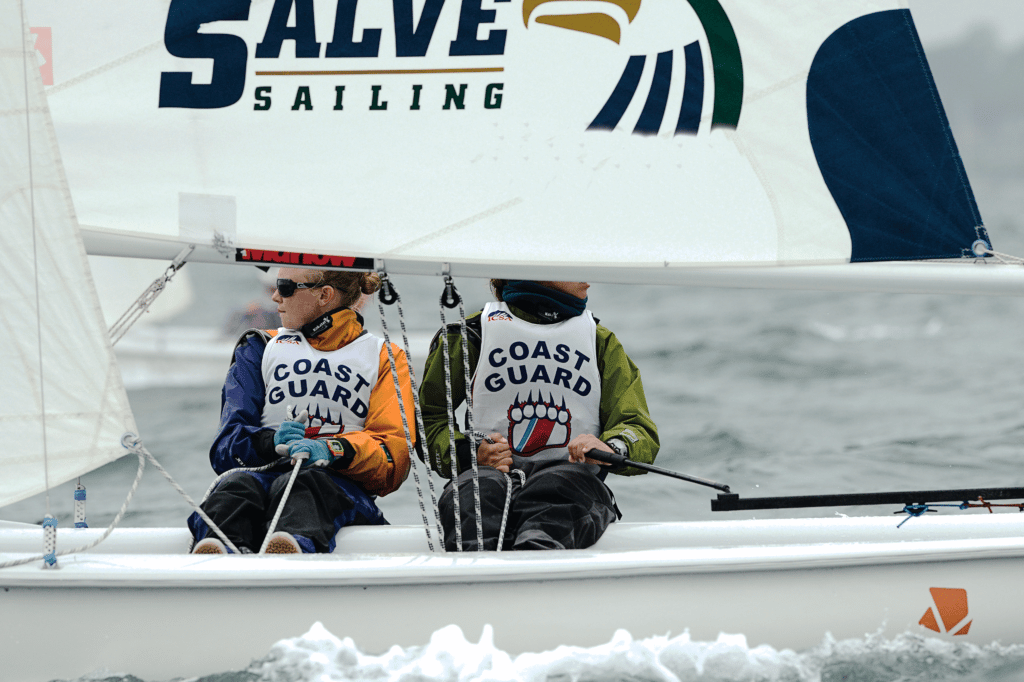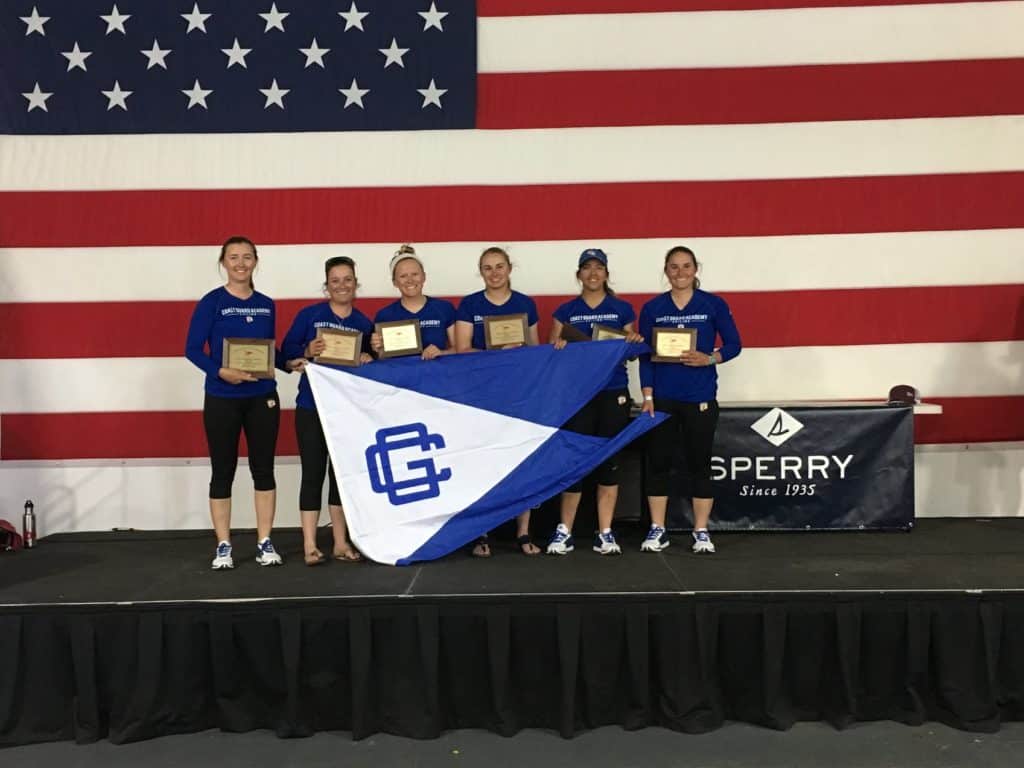
Women sailing in college are a critical part of the sport, and its rich and impressive history speaks to this fact. From the inception of the Intercollegiate Sailing Association in the 1930s, sailing was open to everybody. A few examples include Lorna and Chick Whittelsey competing in the Boston Dinghy Club Challenge Cup in April 1933; and in 1958, the collegiate national champions, the Massachusetts Institute of Technology, included a female crew, Carol Dorworth.
“There were some really phenomenal women’s sailors,” says Mike Horn, coach of the Harvard University sailing team for 32 years and executive director of the ICSA for 14 years.
There were even events exclusive to women college sailors — they were not a part of the ICSA schedule — but the regattas were held specifically for women. Hollywood heartthrob, Humphrey Bogart, even donated a trophy for women’s sailing on the Pacific Coast — again not tied to the ICSA — but for female college sailors. Women have been a valuable part of college sailing from the beginning, and in the 1960s, when women sailors faced exclusion, it only spurred them on to become stronger. In 1961, the University of Rhode Island, an NCAA school, decided it was going to follow NCAA regulations for all school sports, whether the sport was NCAA affiliated or not. Sailing is not an NCAA sport, but Rhode Island made the decision regardless that it would no longer compete against any team that had a woman on it. At the time, URI was one of the strongest teams in New England, so the conference did not want to lose its participation and have it drop out entirely.
In response to this decision, the New England Intercollegiate Sailing Association set up a separate women’s schedule, and the New England Women’s Intercollegiate Sailing Association was born.
“I was still an undergraduate at Harvard University [in 1961], and I was in charge of coordinating the schedule for the women’s association,” says Horn. “I was also coordinating the schedule for what then became the men’s-only association in New England.”
From 1961 to 1975, there were women’s-only events in New England, and no woman was allowed to compete in a men’s event. New England was the only conference in the nation to have this restriction. The Mid-Atlantic conference, however, decided to start a similar association, the Mid-Atlantic Association of Women’s Sailors, to continue to compete with the women in New England. The Mid-Atlantic still had no restriction against women competing in ICSA events. “At this time, even though there were women sailors, the pool of women sailors was very small, so New England, with the establishment of this new association, went on an active campaign to develop and expand the number of women sailing,” says Horn.
Many of the early events for women were combined with clinics or some events, called coed co-skipper (which did not count in the New England men’s association), allowed a male skipper and a female skipper to alternate races in a regatta in an attempt to bolster women’s experience.
“Over this 14-year period, when there were women’s-only events, women’s sailing in New England became very strong — stronger than anywhere else, with few exceptions,” explains Horn. “The Mid-Atlantic association also became strong, and those two districts dominated women’s sailing from the time it started.
“The athletic directors and personnel of women’s colleges in New England played a really active role in pushing the sport,” Horn continues. “Mary Paget, the athletic director at Radcliffe College (sister school of Harvard University); Janet Lutz, who was the athletic director at Pembroke College (sister school of Brown University); Stu Nelson, women’s coach at MIT; Jim Bonnie, who was important at Boston University; and Bonnie Weincke, coach of Wellesley College — they worked really hard to support women’s sailing.”
In 1967, Gerry Miller, a law student at Boston University, came up with the idea of a women’s national championship. He hosted the first one in 1967, and three colleges showed up. Wilson College, from Pennsylvania, won the first title.

In the early 1970s, Steve Taylor, an undergraduate at Yale University, led a campaign to reintegrate women into college sailing. NEISA was unwilling to do so until the women voted to join the men themselves. For a number of years the women voted against it, but in 1975, they agreed and were eligible to sail in coed events in the NEISA conference again. However, the women stipulated that a separate women’s schedule be maintained. It has remained so to this day, both in New England and the Mid-Atlantic.
The number of women’s-only regattas has remained about the same throughout the years, which only speaks to the fact that women sailors want to take advantage of the opportunity to sail in both the premier women’s and coed events. What has changed is the participation of women: There are more women sailing in college today than there ever has been.
“It’s incredibly competitive, and you see a lot more women who are competing both on the women’s side and at the highest level of coed sailing as well,” says Amanda Callahan, head coach for Roger Williams University.
One example of a strong sailor athlete today is Nikki Barnes. Barnes grew up sailing in St. Thomas, USVI, and is now a top skipper in both coed and women’s events for the U.S. Coast Guard Academy. Barnes was named the 2016 Quantum Women’s Sailor of the Year, and she and her team also won the 2016 Sperry Women’s National Championship and placed second at the Gill Coed National Championship.
“Women’s college sailing is absolutely a great avenue for junior women to aspire to,” she says. “It’s hard sailing, and it’s great that women get together to sail because we are the minority in our sport right now.” Despite women participating in college sailing for decades and that the participation has grown, the sport remains predominantly male.
“We are trying a lot of different ways to increase participation in women’s college sailing, and I think we are getting there,” says Mike Callahan, head coach for Georgetown University. “I think there are more women’s teams competing in college, and we have added more berths to the national championship, so we are trying to grow it. In the Mid-Atlantic conference, we try to work with the schedule so we don’t put on important coed events at the same time as women’s so they don’t have to decide between them,” he says.
For the top teams that can field both a coed and women’s team, the sailors are treated as equals.
“The way it works on my team and most varsity teams is that it’s of equal importance to coed,” says Callahan. “You want to win your women’s championship just as much as coed. I think that at the top level it’s just as important, but there are fewer teams that are doing it.”
In some instances, coed sailing still might be a priority over women’s sailing, such as smaller college teams that are just getting started and might prioritize getting into coed regattas rather than women’s.
“I do think [women’s sailing] gets overlooked,” says Barnes. “Just the difference in nationals, there is a lot more hype for the coed championships than there is for the women’s. It seems like we put a lot of hard work into it, but we don’t get the recognition. It is definitely changing and improving, but we are not there yet.”
I’ve sailed both women’s and coed events. My freshman year, I sailed mostly women’s events and was eager to cross over to coed. Not because I did not value women’s sailing, but I felt a difference between the two: There was a friendlier and more open atmosphere on the coed course, which made it fun in a way that women’s sailing was not at the time.
“Women’s sailors are pretty aggressive against each other, like the coeds, but I find when I sail coed events, I have more conversations with people on the water and on the dock than I do at women’s regattas,” says Barnes. “It’s a more open environment. For women’s sailors, it’s always been so hard to prove ourselves as sailors; it needs to start with women making it a more open and friendly environment.”
The depth of talent in the women’s fleet has grown tremendously, but opportunity remains for women sailors to come into their own. Support from college sailing as an association has been helpful, but there’s still progress to be made. At the coaching level, coaches who are supportive of the two disciplines equally can continue to bolster women’s college sailing.
“The fleets are deeper and, to be honest, I think that the very best women are as good as anybody,” says Adam Werblow, head coach for St. Mary’s College of Maryland. “That has always been the case, but there seems to be more of them, and the quality of the racing is deeper all the way down; I think it was pretty clear last year watching the nationals that all the way to 36 teams, people were pretty good.”
College sailing is unique in that it’s coed, so it’s obvious when women beat the guys that women and men can compete evenly, something that many other college sports can’t do. Also, sometimes women decide to crew on the coed team rather than pursue the women’s team, and this can affect participation and strength of women’s sailing.
“I think there is the temptation for teams to grab top women who have a lot of crewing experience to crew,” says Werblow. “When you’re younger on the team and less experienced and you have an opportunity to be a part of the top team in the coed fleet or team racing team, that’s exciting and it’s kind of where some of the action is, so it’s tempting.”
While this can happen, it is certainly not always the case. For Olympic sailor and Boston College graduate, Briana Provancha, she leapt onto the women’s team and led them to great success.
“Coming from high school sailing, I thought it was so cool that there was a separate [women’s] team from the coed team, and that gave more opportunity for women — especially women drivers,” says Provancha. “I crewed in high school, and when I got to college, I drove, and that was a really neat thing for me to do, to get in a boat and skipper — it was fantastic.”
Another unique element of being a woman in college sailing is that women actually do have more available to them than the men. “The freshman women have a huge opportunity no matter which school they go to because they can sail in freshman, women and coed regattas, so they have a lot of chances to get a lot of sailing in,” says Healy.
“Our best crews are competing in both women’s and coed events,” says Callahan. “Our best women’s skippers will also do some crewing on the coed team.” As a female sailor, you can sail all of the disciplines in college sailing.
The consensus on what’s next for women in college is team racing. There are a few women’s team race regattas in New England, and there might be more to come. Maybe one day soon there will be a separate women’s team race schedule emulating the coeds’ — if college sailing can fit it all in.









